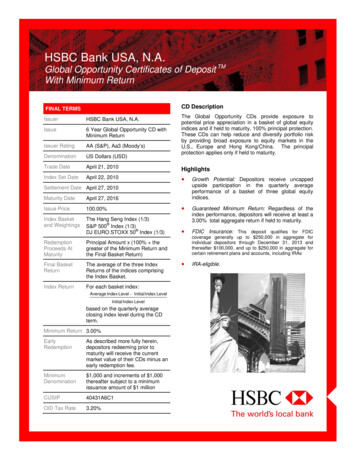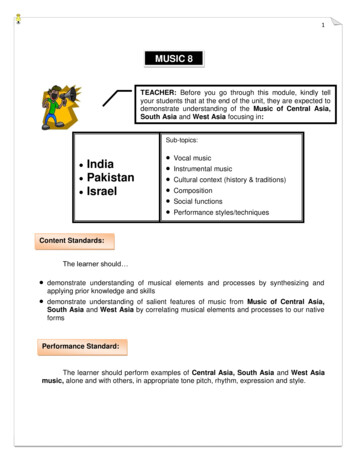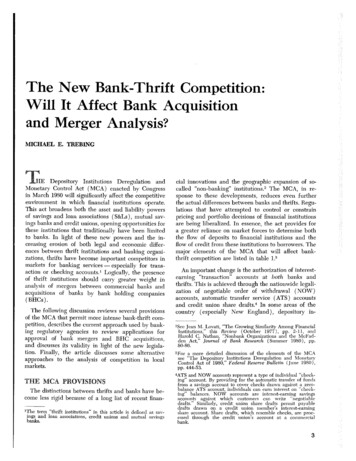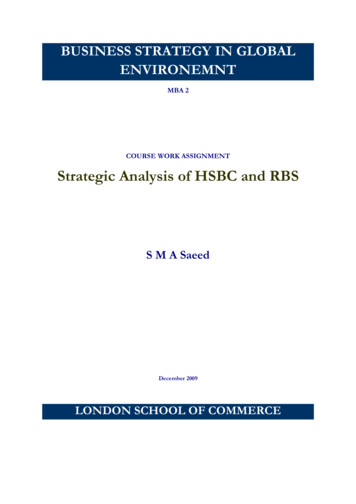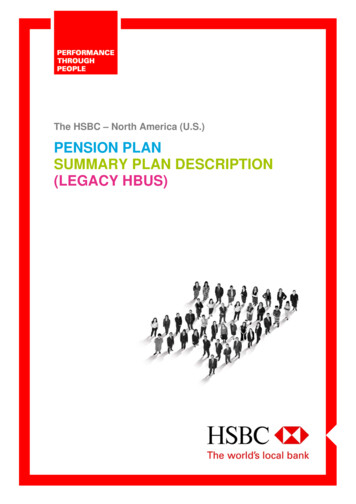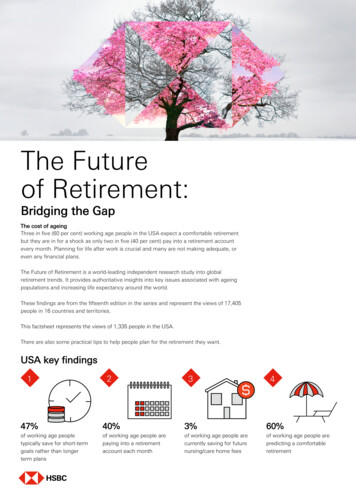
Transcription
PRESS RELEASECanara HSBC Oriental Bank of Commerce Life Insurance CompanyReleases HSBC Study ‘Future of Retirement: Why Family Matters’‘Why Family Matters’, is a part of ‘The Future of Retirement’ series released earlier this yearPresence of children makes a difference to people’s sense of well-being and impactspositively on people’s outlook for the future; However in India, even though 79% of thosewith children expect to be better off in retirement than their parents’ generation, 24% are lessinclined to see retirement as a time of happiness but rather more a time of financial hardshipEven in this age, where women have entered the world of paid employment, worldwide, men(65%) still take the lead with sole responsibility when it comes to planning for their family’slong-term financial needs, leaving women (53%) at greater risk of financial hardship in laterlife; Bucking the global trend, slightly more men (30%) than women (27%) in India take solecharge of household budgeting in contrast to the picture globally, again leaving women lessinvolved in financial mattersNearly half the world’s families are putting themselves at risk by failing to take responsiblesteps to safeguard their future and a gender gap is again evident with 54% of men having afinancial plan compared to just 44% of women; Out of 76% of Indian respondents surveyedwho have a financial plan, 35% of planners in their fifties are not saving for retirement and32% of parents don’t have a life insurance policy in their financial plansFor immediate releaseNew Delhi, December 26, 2011: Canara HSBC Oriental Bank of Commerce Life Insurance CompanyLimited – a joint venture between two of India‟s largest public sector banks, Canara Bank and Oriental Bankof Commerce, and HSBC Insurance (Asia Pacific) Holdings Limited today released HSBC study „Future ofRetirement: Why Family Matters‟ in India. This is a supplementary report to the main 2011 report releasedearlier this year, „The Power of Planning’, the sixth in „The Future of Retirement‟ series.The report looks at people‟s outlook on retirement, some important differences in how people plan for it andother financial needs within different types of households. In particular, it examines the gender gap betweenhow men and women plan and how that gap might be influenced by the onset of children and differences inworking patterns.Looking broadly at the global findings, those without children are more likely to have negative associationswith retirement. This picture contrasts sharply with the Middle East and Asia, where the family unit still playsa strong role in providing a safety net in later life. For example, India, has the highest number of respondents(32%) who wish to live with their children and other family members in retirement, more than twice the globalaverage (14%) and 10 times higher than the USA and the UK and 85% respondent thought that the „jointfamily system‟ will remain either very or quite important in Indian society. Here, even though 79% of thosewith children expect to be better off in retirement than their parents‟ generation, they are less inclined to seeretirement as a time of happiness (37%). In fact parents in India associate retirement with financial hardship(24%) than those without children (19%).According to Mr. John Holden, Chief Executive Officer, Canara HSBC Oriental Bank of CommerceLife Insurance Company, “From the example of India it emerges that while people in these countries mightbe generally quite positive about their retirement prospects, parenthood is not the source of this optimismbecause people are not taking the necessary steps to ensure financial security for their families, which is a1
major cause of concern. It does not make people happier as living with extended family in retirement ispossibly borne of financial dependence and necessity rather than choice.”Another global trend that emerged from the study is that even in today‟s time when women have entered theworld of paid employment, worldwide, men (65%) still take the lead with sole responsibility when it comes toplanning for their family‟s long-term financial needs, leaving women (53%) at greater risk of financialhardship in later life. When it comes to retirement planning, globally men are much more proactive (39%),being twice as likely to take charge of this financial decision solely than women (25%); the trend is mirroredin India with men at 43% and women at 21% taking sole responsibility for retirement planning. Crucially, thismeans that globally women are much more focused on short-term financial matters and are more likely to beoverlooking the importance of planning for retirement in their own right. Further, women are more likely tofocus on managing the household budget, with 37% of women taking sole responsibility compared to 34% ofmen. This was the only area in financial planning where women said they were more likely to take soleresponsibility. However, in India, slightly more men (30%) than women (27%) in India take sole charge ofhousehold budgeting in contrast to the picture globally, again leaving women less involved in financialmatters.Only 50% of respondents globally say they have a financial plan in place for their own or their family‟s futureand even here, significant gaps were evident. A gender gap also emerges with 54% of men having afinancial plan compared to just 44% of women. From the 50% of people surveyed who stated they had afinancial plan in place, nearly half (47%) of them are not saving for retirement, and this remains high evenamong those in the immediate pre-retirement age (37% of 50 to 59 year olds).The study also highlighted the presence of a major protection gap evident in all 17 countries surveyed. Manyparents seem not to understand the consequences of no insurance – which exposes them to risk of beingunable to cope if there is a change in their circumstances, by way of ill health and consequent loss of anincome. Less than half of parents had individual term insurance in 14 of the 17 countries surveyed. OnlyIndia, South Korea and Taiwan scored above 50% in terms of families having term life insurance with Indiatopping the list with 59%. Surprisingly, there was virtually no difference in life insurance penetration infamilies with or without children - Only 55% of parents with financial plans have some sort of life insurancecontained in it. This compares to 52% of those who did not have children.Some of the key responses from the 76% of Indian respondents surveyed who have a financial plan in placehighlighted some major gaps - for example, 35% of planners in their fifties are not saving for retirement anddespite the fact that life insurance is widely available and all working parents have a need for this kind ofprotection, 32% of parents do not have a life insurance policy in their financial plans.Households in the East are less risk-averse than their counterparts in the West, and are more likely topursue long-term investing instead of security in the short term. There is a greater proportion of risk-aversehouseholds in developed markets such as France (51%), Canada (42%), the US (45%) and the UK (39%).One reason why households in Eastern markets – like (12%) China and India (21%) – have a higher risktolerance is that they have to deal with higher levels of inflation (typically around 6-8% per annum), andtherefore, need to seek out higher returns in order to protect the real value of their savings and investments.Mr Holden said, “Many financial needs are driven by key life events – including getting married and havingchildren – and as the family is central to these life events, it is an important consideration in building a pictureof an individual‟s long-term financial needs. What emerges from the study however is that people bothglobally and in India are putting their families at risk by failing to make a proper financial plan in accordancewith their needs. At the same time, people who have financial plans in place, have evident gaps with largenumbers of younger families without life insurance in place, while many still overlook the need to buildretirement savings especially women across all age groups who continue to lag behind their male peers and2
women are left exposed to financial hardship in later life. Regarding consumer attitudes to financial risk, it isevident that investment risks are not understood well and gender differences exist that may againdisadvantage women. Many people still prefer to apply a do-it-yourself approach to financial planning. Whilstthis is positive that people are taking greater personal responsibility for their finances, people shouldn‟t seethis as a substitute for getting expert financial advice on how to make their money work as hard as possible.”Basis this fact and the findings, the research identifies four actions households can take to improve theirfuture financial well-being:1. Share your financial decision-making – retirement and protection needs should be discussed withthe partner to ensure that both are better prepared for retirement and other life goals2. Use life events to start and review your financial plan – understand the importance of life events andlife stages (having children, saving for college, bereavement etc); it is important to consider theneeds of the whole family3. Review your financial plan with a professional adviser – sense-check financial decisions and planswith an expert to ensure that all eventualities are covered4. Take a balanced approach to managing investment risk – balance the need to protect yourinvestments in the short and medium term to generate an adequate retirement income in the longtermThere is an urgent need to raise basic levels of financial literacy among people, a key to encourage andensure financial planning within households. As the Internet is fuelling greater financial engagementespecially among young consumers, financial service providers should develop sophisticated tools andonline resources to create more interest and awareness among consumers and empower them by providinginformation. Further, as 43% respondents have not sought professional financial advice, there is anopportunity for financial service providers especially banks to ensure engagement through financialeducation and awareness campaigns especially for women so that they are less vulnerable to the risk offinancial hardship in later life.Mr Holden added, “Canara HSBC Oriental Bank of Commerce Life Insurance Company, which operates abancassurance model, is at an advantageous position because of the bank partners‟ financial strength,expertise, distribution reach and most importantly, trust. Customer education and need-based advice hasbeen our focus right from the beginning. We have taken proactive steps to educate customers on the needfor protection, disciplined savings and retirement planning through around 990 customer meets where boththe husband and wife are invited. Further, specific events have been organised for women customers of ourpartner banks as well as for women from the underserved communities through our partner NGOs as part ofour corporate social responsibility.”Taking insights from the key findings of the study, the Company launched Life Insurance Simulator (LIS), aninteractive online planning tool that takes the customers through a series of simple steps to assess whethertheir current savings and investments are adequate to fulfill their needs. LIS is available onwww.canarahsbclife.com in English, Hindi, Punjabi and Kannada. This has been a big hit with our customersin creating awareness and interest in their own financial planning needs and solutions. ”To ensure that general optimism towards financial planning and retirement should not lead to complacency,Canara HSBC Oriental Bank of Commerce Life Insurance will continue to focus on promoting financialdiscipline and retirement planning through life insurance, guiding customers to prepare and plan to enjoy anextended period of later life.-Ends-3
Notes to EditorsThe Future of Retirement: Why Family MattersThis report, Why Family Matters, is a supplementary report to the main 2011 report, The Power of Planning,the sixth in „The Future of Retirement‟ series. Both reports highlight findings from a survey of more than17,000 people in 17 countries.The report surveyed 17,849 „financial trendsetters‟ of working age (mostly between 30 and 60 years) in 17countries - India, Argentina, Brazil, Canada, China, France, Hong Kong, Malaysia, Mexico, Poland, SaudiArabia, Singapore, South Korea, Taiwan, UAE, UK, and the USA. Financial trendsetters tend to be moreeducated than average, live in urban areas and have greater access to the internet. Those in developingeconomies tend to share the same attitudes and behaviour of those in the developed world, includingattitudes towards retirement planning.The research was conducted online in December 2010 and some survey data was collected on both ahousehold and individual basis.The report refers to three distinct income groups: high income with gross annual household income overUS 100,000 (20% of sample); middle income with gross annual household income of US 30,000 toUS 100,000 (30% of sample); and low income with gross annual household earnings below US 30,000(50% of sample).*India Sample Size: 1028 778 men surveyed and 250 women Three age bands:- 30-39: 392 39%- 40-49: 368 37%- 50-70*: 240 24%(we had 1 respondent aged between 60-70)The Future of Retirement 2011: The Power of PlanningThe Power of Planning was the first report produced from the research which surveyed over 17,000 peoplefrom 17 countries in December 2010. It focused on the importance of planning for a happy retirement, andthe steps people can take towards building an effective financial plan. Key findings included: Nearly 1-in-5 respondents (19%) did not know what their main source of retirement income would be Respondents in the West believe they will be worse off than their parents‟ generation, while in emergingmarkets, people believe they will be better off 50% of respondents worldwide did not have a financial plan in place On average, those with financial plans amassed nearly two-and-a-half times more in retirement savingscompared to those without plans, a „planning premium‟The Future of Retirement ProgrammeHSBC‟s The Future of Retirement programme is a world-leading independent study into global retirementtrends. It provides authoritative insights into the key issues associated with ageing populations andincreasing life expectancy around the world.Since the Future of Retirement programme began in 2005, more than 110,000 people worldwide have beensurveyed. The research findings help HSBC and its partners around the world to understand and meet theneeds of its 89 million customers worldwide. The programme has helped advance retirement thoughtleadership, and raised awareness of HSBC as a leader in the growing retirement services market.4
The supplementary report - The Future of Retirement: Why Family Matters and the India Fact Sheet canbe downloaded from www.canarahsbclife.comThe main report - The Future of Retirement: The power of planning and the India Report can also bedownloaded from www.canarahsbclife.comFor further information on the Future of Retirement Programme and previous reports, visitwww.hsbc.com/retirementAbout Canara HSBC Oriental Bank of Commerce Life Insurance Company Limited(www.canarahsbclife.com)Canara HSBC Oriental Bank of Commerce Life Insurance Company Limited was launched in June 2008and is jointly owned by two of India‟s largest public sector banks – Canara Bank (holding 51%) andOriental Bank of Commerce (23%) – and HSBC Insurance (Asia Pacific) Holdings Limited (26%), theAsian insurance arm of one of the world‟s largest banking and financial services groups – HSBC.The Company has exclusive access to around 53 million customers and a pan-India network of over 4800branches of Canara Bank, HSBC and Oriental Bank of Commerce. The formidable distribution strength andin-depth local market knowledge of Canara Bank and Oriental Bank of Commerce coupled with theconsiderable insurance experience, product range and proven bancassurance capabilities of HSBC makethis an unparalleled union of financial strength, expertise and most importantly, trust.To deliver affordable insurance solutions to address the needs of the rural population, the social sector andeconomically weaker sections of the society, especially those who have no or very little access to organisedfinancial services, the Company tied up with three Rural Regional Banks (RRBs) – Pragathi Gramin Bank inKarnataka, Shreyas Gramin Bank in Uttar Pradesh and South Malabar Gramin Bank in Kerala that have anetwork of around 790 branches and reach out to more than 7 million customers.Canara HSBC Oriental Bank of Commerce Life Insurance Company understands that today innovation is akey differentiator. Based on market demand and customer preferences, the Company currently offers 12products – 4 unit-linked and 8 traditional; 7 out of these are individual and 5 are group products.Canara HSBC Oriental Bank of Commerce Life Insurance Company is the fastest Indian life insurancecompany to cross Rs 500 crore, Rs 1000 crore, Rs 1500 crore and Rs 2000 crore in weighted premiumincome till date. Since launch on June 16, 2008 to November 30, 2011, the Company‟s business in terms ofGross Written Premium (GWP) stood at Rs 3,800.3 crore and the number of policies sold are 288,473. As onNovember 30, 2011, the Company‟s assets under management (AUM) stood at Rs 3467.16 crore.Media Enquiries:Canara HSBC Oriental Bank of Commerce Life Insurance Company LimitedNonika Raj Kumar 91 124 4535658nonika.rajkumar@canarahsbclife.in 91 9717882227IPAN Hill & KnowltonPinky Singh 91 124 4967300psingh@ipanhillandknowlton.com5
1 PRESS RELEASE Canara HSBC Oriental Bank of Commerce Life Insurance Company Releases HSBC Study ‘Future of Retirement: Why Family Matters’ ‘Why Family Matters’, is a part of ‘The Future of Retirement’ series released earlier this year Presence of children makes a difference to people’s sense of well-being and impacts posi

